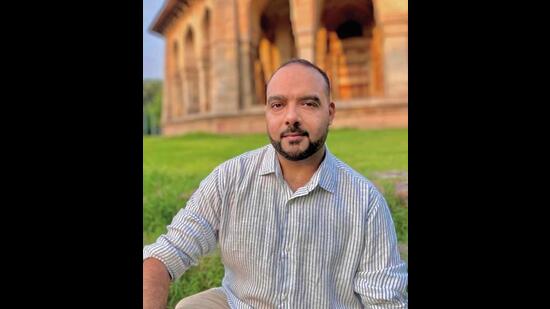Review: Tripping Down The Ganga by Siddharth Kapila
Siddhartha Kapila's "Tripping Down The Ganga" explores young Indians' complex relationship with faith, balancing skepticism and spirituality in a thought-provoking journey.
For many young Indians, their faith is in a perennial state of flux. They roll their eyes when they are asked to perform religious rituals but seem to enjoy being a part of things from afar. Their participation is non-committal, the kind that maintains a safe distance. This allows them to dismiss faith’s regressive aspects while also leaning into its more aesthetic parts. Are they cool atheists or even cooler agnostics? Then there are, of course, the overly religious folks. So, is there an in-between?


In Tripping Down The Ganga, author Siddhartha Kapila asks a pertinent question: Why, in some liberal Indian circles, is atheism considered a more sophisticated, socially-acceptable position to take? Why is being overly religious looked down upon, even associated with being ignorant? He then urges young readers to turn this critical gaze inwards.
Much of the inspiration for the seven-year-long journey, both spiritual and actual, down the country’s holiest river documented in this 472-page work comes from the author’s devout Shiv bhakt mother. Kapila attempts to critically examine the ideas of faith that she has passed down to him even as he is cognizant of the rationalism of his atheist father. Indeed, so atheist is Kapila Senior that he tells his wife: “You better not put my ashes in any filthy river after I go, dear lady. I’d rather you put me in the gutter”.
Divided into seven parts, the book examines ideas of belief and spirituality with “one leg in the digital age, the other dipped in the rivers of faith.” Along the way, the reader hears from rishis, sadhus, kanwariyas, babas, nagas and aghoris and witnesses the author attempting to balance the rational with the spiritual.
This could have devolved into a mere travelogue with some ersatz religiosity thrown in. But the author’s documentation of his visits, which is shot through with an acute awareness of his own privilege as an upper caste Hindu man, lift it into something more thoughtful and intellectually stimulating. He is careful to stick to the culturally familiar area of north India so his conversations with locals are authentic and avoid any unintentional misinterpretations that might show up with southern devotees. And he wisely devotes attention to food and the connected notions of purity or the absence of it -- a preoccupation with observant Hindus. Kapila acknowledges the political nature of food, the idea of non-vegetarian food being ‘impure’ and how that is extrapolated into caste identity. All of this isn’t presented in dry sociological passages but appears through the people and situations presented in the book.
Take Sehdav Uncle, a key character, who can barely converse in English. He is more religious than the author’s mother, who “rejected Arya Samaj when they rejected idol worship”. Kapila and his friend Arjun look down upon the older man, deliberately bringing up their consumption of meat and subliminally dissing his beliefs. It is their way of rebelling against the religious codes of their parents. Still, those codes are difficult to escape entirely. Years later, Kapila tries beef for the first time during a visit to Japan and immediately feels guilty.
Images are conjured with words. The reader sees the ghungroo-clad, chillum-smoking, intoxicated kanwariyas managing to complete a hundred-kilometer journey in 20 hours and the thousands of ascetics gathering for Shahi Snaan like an ‘effervescent organism’. You are also confronted by the bizarre: there’s the Naga Sadhu who can lift weight with his penis and the aghori jostling with a dog over a human skull. Through it all, the author emerges as a seeker, one of many who feel connected to each other among the melee of thousands of devotees at the Kumbh Mela. Kapila’s faith isn’t blinkered, however, and he does touch on Hindutva and acknowledges the existence of rank bigotry.
Skepticism and belief, the rational and the spiritual constantly tussle though the seven parts of the book even as the author’s persona steadily inclines more towards spiritualism. The identification with a larger Hindu identity and a certain spiritual growth becomes apparent when he is overpowered by a strong urge to defend the kanwariyas after he reads a news bulletin that brands them as ‘hooligans’. On a poignant note, he writes of performing his non-believer father’s pind daan, a ritual for the departed. He writes too of calling up his mother during Covid to help with pranic healing.

I am a non-believer who often asks his mother for pranic healing. I performed pind daan for my father when I was barely 11 years old, and didn’t fully understand its significance. Unsurprisingly, Kapila’s book hit close to home. As a young urban upper caste Hindu man, it was eye-opener and has made me want to take a trip down the Ganga to explore some of these ideas myself.
Kapila’s story will resonate with many young Hindus, especially, who oscillate between belief and scepticism, between bhakti and atheism. Impressively, he also acknowledges that being able to explore his faith by taking these trips is a privilege in itself — a moment of self-awareness rarely seen in authors. Tripping Down the Ganga will urge you to introspect about faith and what it means to you.
Deepansh Duggal writes on art and culture. Twitter: @Deepansh75.






